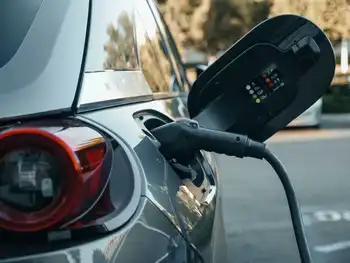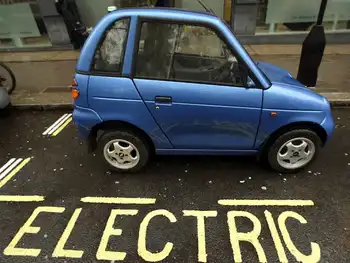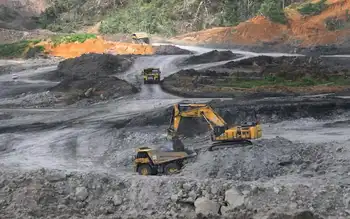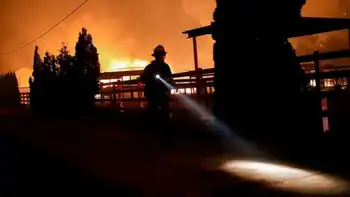Spinning flywheels said to make greener energy
By Associated Press
NFPA 70e Training
Our customized live online or in‑person group training can be delivered to your staff at your location.

- Live Online
- 6 hours Instructor-led
- Group Training Available
Beacon Power's flywheels — each weighing one ton, levitating in a sealed chamber and spinning up to 16,000 times per minute — will make the electric grid more efficient and green, the company says. It's being given a chance to prove it: the U.S. Department of Energy has granted Beacon a $43 million conditional loan guarantee to construct a 20-megawatt flywheel plant in upstate New York.
"We are very excited about this technology and this company," said Matt Rogers, a senior adviser to the Secretary of Energy. "It's a lower (carbon dioxide) impact, much faster response for a growing market need, and so we get pretty excited about that."
Beacon's flywheel plant will act as a short-term energy storage system for New York's electrical distribution system, sucking excess energy off the grid when supply is high, storing it in the flywheels' spinning cores, then returning it when demand surges. The buffer protects against swings in electrical power frequency, which, in the worst cases, cause blackouts.
Such frequency regulation makes up just 1 percent of the total U.S. electricity market, but that's equal to more than $1 billion annually in revenues. The job is done now mainly by fossil-fuel powered generators that Rogers said are one-tenth the speed of flywheels and create double the carbon emissions.
Beacon said the carbon emissions saved over the 20-year life of a single 20-megawatt flywheel plant are equal to the carbon reduction achieved by planting 660,000 trees.
Flywheels also figure into the emerging renewable energy market, where intermittent energy sources such as wind and solar provide power at wildly varying intensities, depending on how long the breeze blows and sun shines. That increases the need for the faster frequency buffering, Rogers said.
Dan Rastler of the Electric Power Research Institute, an industry research group, added that if a carbon tax is passed by Congress, flywheels start looking a lot better than fossil-fuel powered alternatives.
Beacon's flywheels, massive carbon and fiberglass cylinders, have already been tested on a small scale in New York, California and the company's Tyngsborough offices. Chief executive officer Bill Capp hopes the Stephentown, N.Y., plant will be up and running by the end of 2010.
Flywheels are rotating discs or cylinders that store energy as motion, like the bicycle wheel that keeps rotating long after a pedal's been turned. That energy can be drawn off smoothly depending on the needs of the user, such as when the speed of a potter's wheel is adjusted to shape the clay as desired.
The basics of Beacon's flywheels seem simple enough as they spin silently in their chambers in a small facility outside Beacon's Tyngsborough plant. But the technological challenges to create them were immense and have cost Beacon $180 million, so far.
For instance, the one-ton flywheel had to be durable enough to spin smoothly at exceptionally high speeds. To avoid losing stored energy to friction, the flywheel levitates between magnets in a vacuum chamber.
"We've pretty much demonstrated that it works, it's just a question of scaling," Capp said. "The more we run, the more people get comfortable with us."
Beacon's flywheels are powered by the excess energy they take off the grid. When demand for electricity surges, the flywheels even things out and return the energy to the grid by slowing down.
Flywheels have some clear benefits in energy storage, including the durability to store and release power hundreds of thousands of times over a long, 20-year life, said Yuri Makarov, chief scientist in power systems at Pacific Northwest National Laboratory, which tested Beacon's system for the DOE. Chemical batteries being developed for the same job wear out after a couple thousand charge-and-discharge cycles.
Flywheels use less energy than fossil-fuel powered generators because they adjust more quickly to the ever-shifting demands of the electric grid by simply slowing down or spinning faster, Makarov said. Fossil-fuel generators are slower and less efficient as they constantly fire up and down.
The disadvantage of flywheels, Makarov said, is that they can only store a limited amount of energy for a limited amount of time. That can shut them out of numerous other services the grid demands — and that other storage technologies can perform — such as long-term power storage.
Regulations in many markets are also lagging. Beacon will bid against other power generators to provide frequency regulation, but in some markets, the bidding system doesn't even exist yet for energy storage.
Beacon's reward for taking on the technology is that it's the first flywheel company in the nation ready to provide utility-scale frequency regulation in the electric grid. Rogers said the New York project will help show whether the flywheels can do the job:
"If they're successful in New York, we'd expect this kind of technology to be picked up in many other markets around the country," he said.















